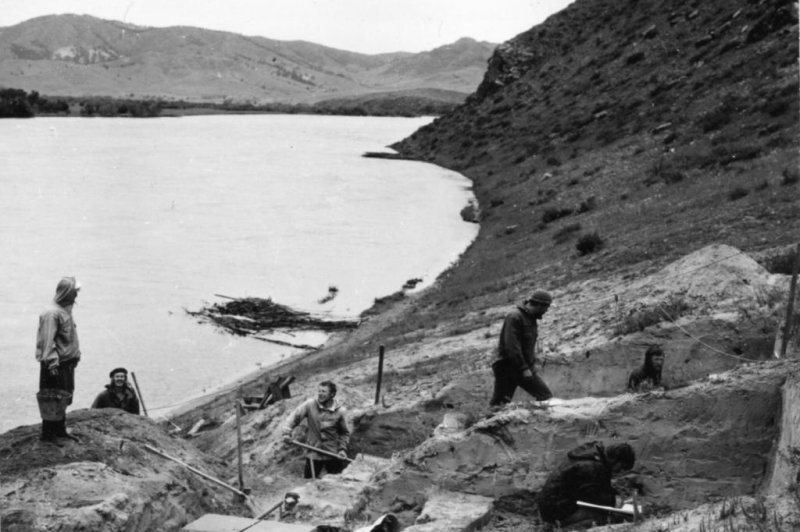
Siberia's Lake Baikal region has been populated by modern humans since the Upper Paleolithic. Ancient populations left behind an extensive archaeological record. This photo shows the 1976 excavation of the Ust'-Kyakhta-3 site located on Russia's Selenga River. Photo by A. P. Okladnikov
May 20 (UPI) -- Using genomic analysis, scientists have traced the oldest link between the earliest Native American populations and the people of Siberia's Lake Baikal region.
Modern humans have populated the lands surrounding Lake Baikal since the Upper Paleolithic. Previous studies of the region's population dynamics suggest the transition from the Neolithic to the Bronze Age was marked by genetic turnovers and admixture events, but the timing of the human migrations and cultural interactions that characterized this place and time in human history aren't well understood.
New genomic analysis of ancient remains in Siberia -- detailed this week in the journal Cell -- have offered scientists fresh insights into the movements of human populations across Eurasia and into the Americas at the end of the Stone Age.
"Previous studies observed the genetic differences between individuals from different time periods, but didn't investigate the differences by dating the admixture events," lead study author He Yu, postdoctoral researcher at the Max Planck Institute for the Science of Human History in Germany, told UPI in an email. "Our study reports a 14,000-year-old individual, which actually fills in a large blank of ancient genomes in this region, between 23,000 and approximately 8,000 years ago."
RELATED Siberian permafrost yields 46,000-year-old horned lark
Yu and his colleagues were able to stitch together a genome from DNA recovered from the tooth of the 14,000-year-old individual, revealing ancient links between the people of the Lake Baikal region and early Native American populations.
"The deep connection observed in this study is sharing of the same admixed ancestry between Upper Paleolithic Siberian and First Americans," Yu said. "We are not suggesting interbreeding between Native American and Siberian, or any back flow of Native American ancestry into Siberia. But we are suggesting that, the First American ancestry was formed in Siberia and also existed there, in a large range of time and space, so we can detect it in ancient Siberian individuals."
Armed with DNA from several Lake Baikal fossils, scientists deployed a variety of sophisticated genomic analysis methods to establish relationships between different ancient populations in the Eurasia and the Americas.
RELATED Hot pots helped ancient Siberian hunters stay alive, warm
"For genetic background analysis, we first compared the new individuals with published data to see how they were related with known populations, then zoomed in to their differences with closely related populations," Yu said.
Two of the individuals from southern Siberia showed strong genetic similarities to populations from northeastern Asia, groups previously linked with the ancestry of the earliest Native Americans. The findings suggest the genetic heritage of the earliest Native Americans was already widespread across Siberia by the early Bronze Age.
Scientists also surveyed the ancient Siberian genomes for evidence of disease. Their efforts revealed the presence of Yersinia pestis, the plague-causing pathogen, in two individuals. DNA analysis showed the infected individuals hailed from northeast Asia, but the bacteria's genetic signatures suggest the pathogen came from western Eurasian steppe -- further evidence of widespread movement and complex contact among Eurasian populations.
RELATED Ancient litter on cave floor offers insight into lives of early humans
"Early Bronze Age is the era of population mobility and communication, and such phenomenon has been observed in many other regions, especially western Eurasia," Yu said. "Our study is the first to report such long-range mobility in southern Siberia."
RELATED Humans arrived in Americas earlier than thought, new Idaho artifacts suggest
No comments:
Post a Comment